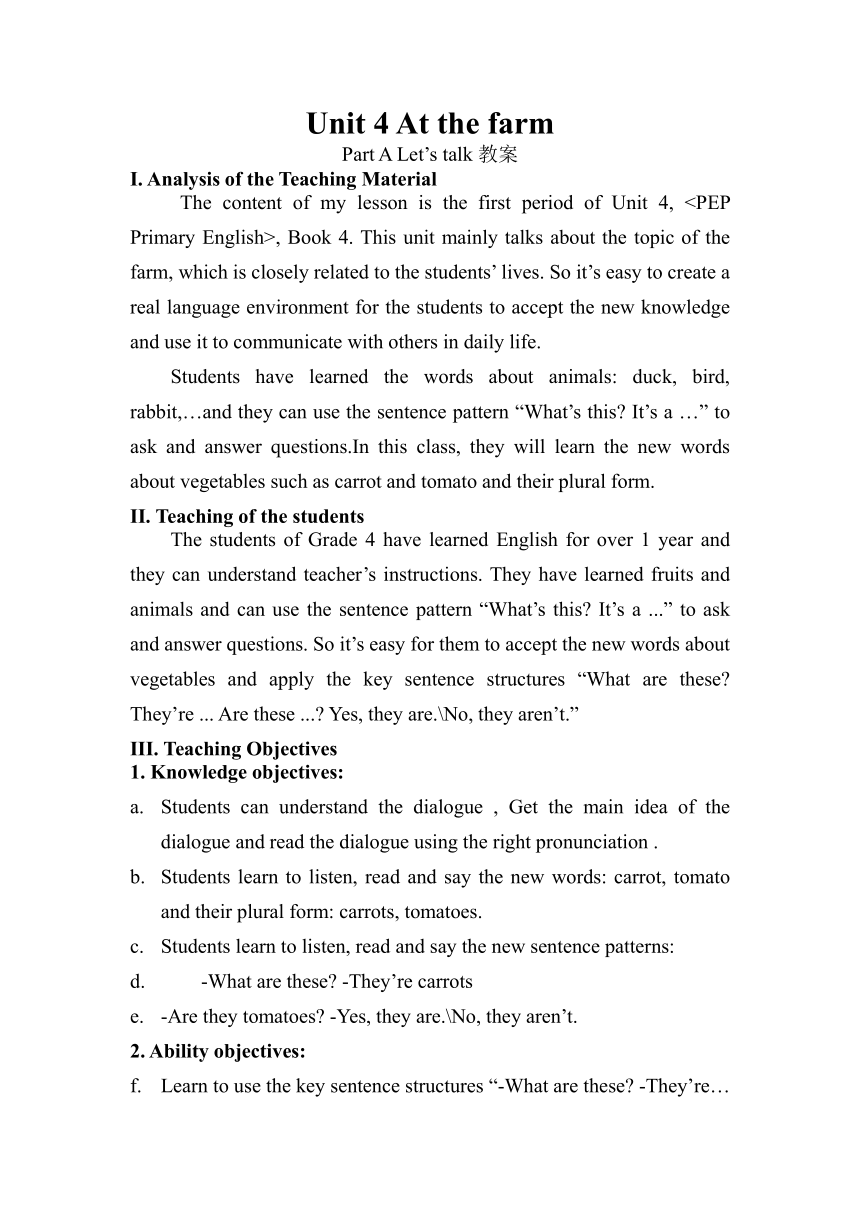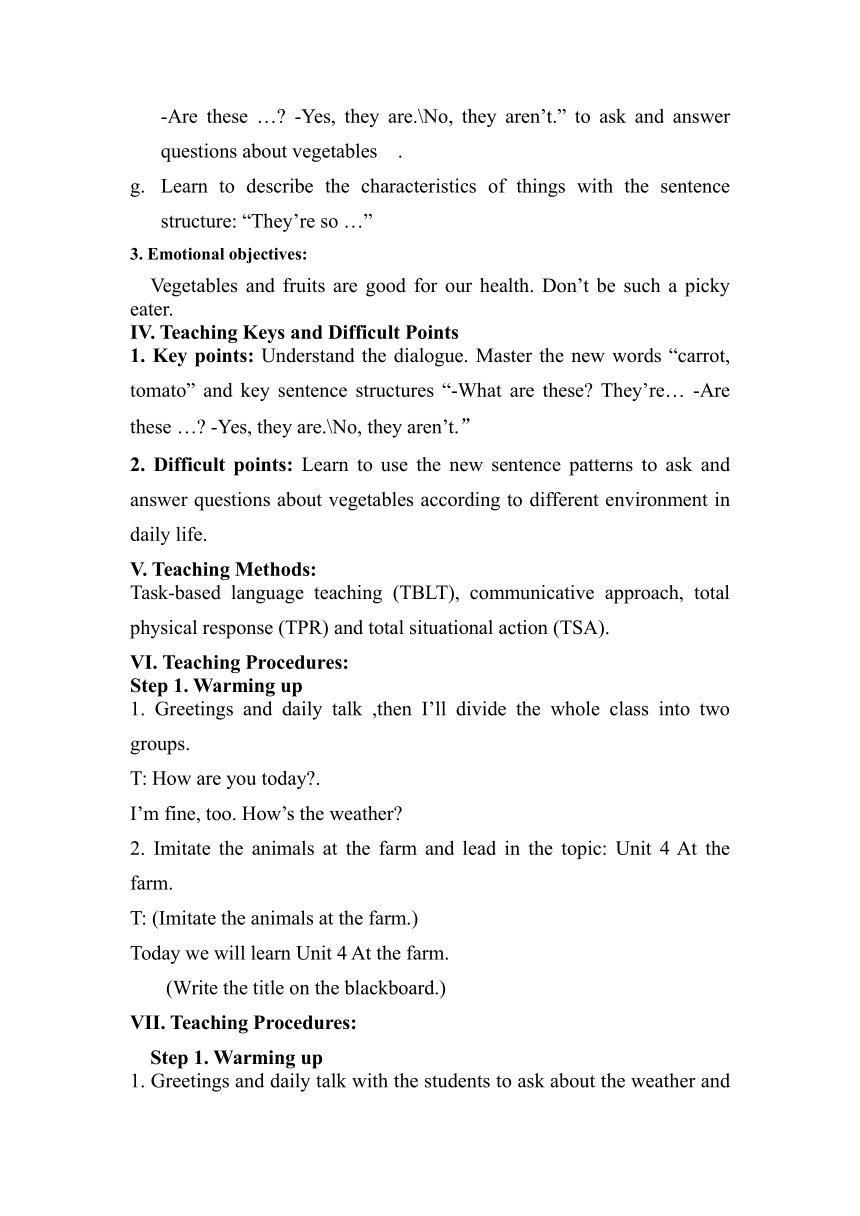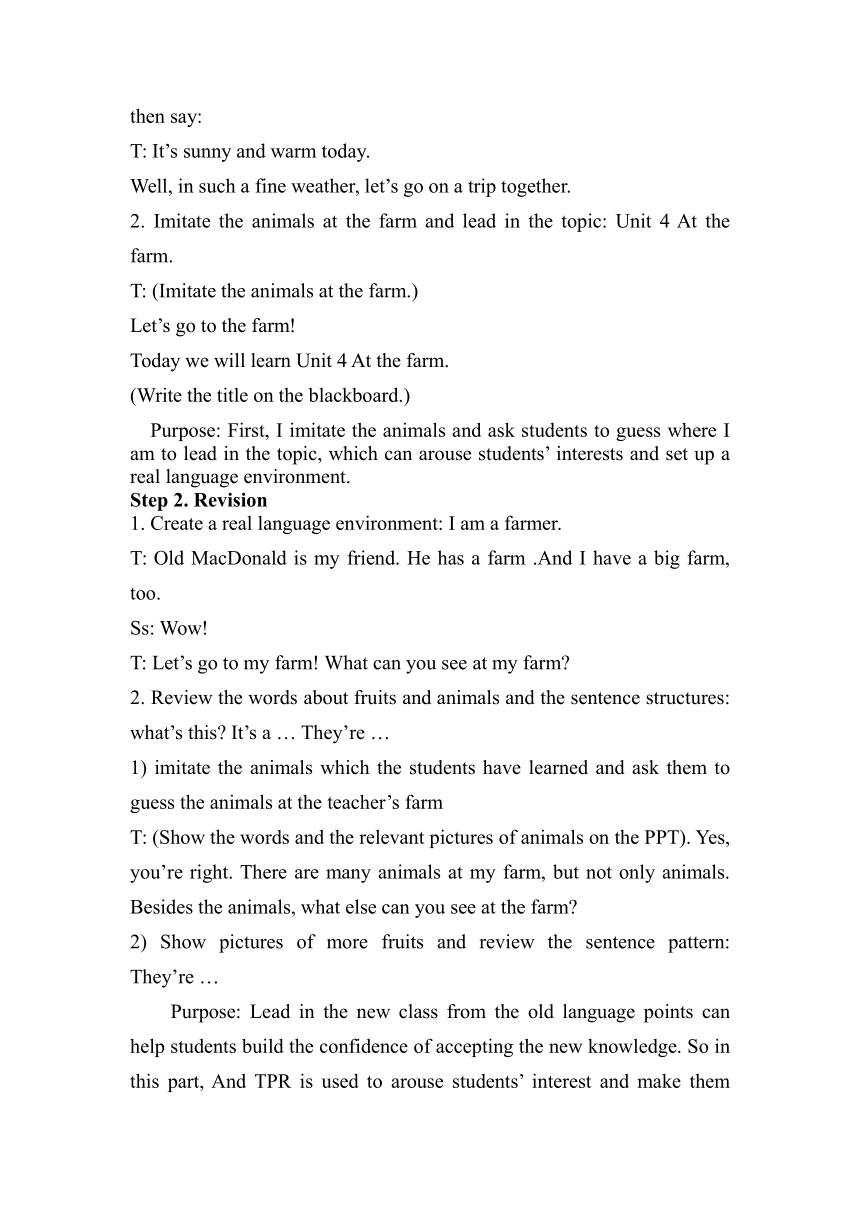Unit 4 At the farm Part A Let’s talk 教案(全英)
文档属性
| 名称 | Unit 4 At the farm Part A Let’s talk 教案(全英) |  | |
| 格式 | docx | ||
| 文件大小 | 150.2KB | ||
| 资源类型 | 教案 | ||
| 版本资源 | 人教版(PEP) | ||
| 科目 | 英语 | ||
| 更新时间 | 2022-01-18 16:19:13 | ||
图片预览



文档简介
Unit 4 At the farm
Part A Let’s talk教案
I. Analysis of the Teaching Material
The content of my lesson is the first period of Unit 4,, Book 4. This unit mainly talks about the topic of the farm, which is closely related to the students’ lives. So it’s easy to create a real language environment for the students to accept the new knowledge and use it to communicate with others in daily life.
Students have learned the words about animals: duck, bird, rabbit,…and they can use the sentence pattern “What’s this It’s a …” to ask and answer questions.In this class, they will learn the new words about vegetables such as carrot and tomato and their plural form.
II. Teaching of the students
The students of Grade 4 have learned English for over 1 year and they can understand teacher’s instructions. They have learned fruits and animals and can use the sentence pattern “What’s this It’s a ...” to ask and answer questions. So it’s easy for them to accept the new words about vegetables and apply the key sentence structures “What are these They’re ... Are these ... Yes, they are.\No, they aren’t.”
III. Teaching Objectives
1. Knowledge objectives:
Students can understand the dialogue , Get the main idea of the dialogue and read the dialogue using the right pronunciation .
Students learn to listen, read and say the new words: carrot, tomato and their plural form: carrots, tomatoes.
Students learn to listen, read and say the new sentence patterns:
-What are these -They’re carrots
-Are they tomatoes -Yes, they are.\No, they aren’t.
2. Ability objectives:
Learn to use the key sentence structures “-What are these -They’re… -Are these … -Yes, they are.\No, they aren’t.” to ask and answer questions about vegetables .
Learn to describe the characteristics of things with the sentence structure: “They’re so …”
3. Emotional objectives:
Vegetables and fruits are good for our health. Don’t be such a picky eater.
IV. Teaching Keys and Difficult Points
1. Key points: Understand the dialogue. Master the new words “carrot, tomato” and key sentence structures “-What are these They’re… -Are these … -Yes, they are.\No, they aren’t.”
2. Difficult points: Learn to use the new sentence patterns to ask and answer questions about vegetables according to different environment in daily life.
V. Teaching Methods:
Task-based language teaching (TBLT), communicative approach, total physical response (TPR) and total situational action (TSA).
VI. Teaching Procedures:
Step 1. Warming up
1. Greetings and daily talk ,then I’ll divide the whole class into two groups.
T: How are you today .
I’m fine, too. How’s the weather
2. Imitate the animals at the farm and lead in the topic: Unit 4 At the farm.
T: (Imitate the animals at the farm.)
Today we will learn Unit 4 At the farm.
(Write the title on the blackboard.)
VII. Teaching Procedures:
Step 1. Warming up
1. Greetings and daily talk with the students to ask about the weather and then say:
T: It’s sunny and warm today.
Well, in such a fine weather, let’s go on a trip together.
2. Imitate the animals at the farm and lead in the topic: Unit 4 At the farm.
T: (Imitate the animals at the farm.)
Let’s go to the farm!
Today we will learn Unit 4 At the farm.
(Write the title on the blackboard.)
Purpose: First, I imitate the animals and ask students to guess where I am to lead in the topic, which can arouse students’ interests and set up a real language environment.
Step 2. Revision
1. Create a real language environment: I am a farmer.
T: Old MacDonald is my friend. He has a farm .And I have a big farm, too.
Ss: Wow!
T: Let’s go to my farm! What can you see at my farm
2. Review the words about fruits and animals and the sentence structures: what’s this It’s a … They’re …
1) imitate the animals which the students have learned and ask them to guess the animals at the teacher’s farm
T: (Show the words and the relevant pictures of animals on the PPT). Yes, you’re right. There are many animals at my farm, but not only animals. Besides the animals, what else can you see at the farm
2) Show pictures of more fruits and review the sentence pattern: They’re …
Purpose: Lead in the new class from the old language points can help students build the confidence of accepting the new knowledge. So in this part, And TPR is used to arouse students’ interest and make them fully participated.
Step 3. Presentation
1. Lead in the new words and sentence patterns:
1) Teach the new words: carrot, tomato and the sentence pattern: What are these They’re...
a. Describe the carrot and ask students to guess.
T: There are not only fruits and animals, but also some vegetables at my farm. Please guess: what’s at my farm
It’s red. It’s long. The rabbits like it.
b. play a guessing game and guess the vegetables of carrot and tomato. Then review the learned sentence pattern by asking and answering questions:
-What’s this -It’s a carrot.
c. Show more carrots and teach the plural form of carrot: carrots and then
lead in the new sentence structure: -What are these -They’re carrots.
d. Take out a plate with some fruits in it, let the students try some and use
these sentence structures say: Try some…have some…Mm, they ‘re______
2) Teach the new sentence pattern: -Are these... -Yes, they are.\No, they aren’t.
Show pictures of some apples, yellow tomatoes by PPT and ask students :
T: Are these tomatoes
Ss: Yes., they are./ No, they aren’t.
3. Dialogue teaching.
1) Show the picture in let’s talk.
T: Well, I have a farm, uncle Wang has a beautiful farm, too. Look! Here come your friends Mike and Sarah at his farm. Let’s go to uncle wang’s farm.
2) 3) Show some questions on the screen. Then ask students to listen again and then read and find the answers by themselves.
① what are they talking about
② Are the carrots big or small
③ What colour are the tomatoes
4)Discuss in groups and check the answers.
5) Listen for the second time and read after the tape. Pay attention to the pronunciation.
6) Ask students to practice reading by themselves and then ask them to read in different roles.
7) Show some pictures on the screen , choose a picture ,using these sentences structures to make a short dialogue.
Purpose: Let students learn with curiosity can be more efficient. So while teaching the new words carrot and tomato, I describe the words and ask them to guess, which is more interesting than teaching directly. While learning the new sentence patterns, I try to lead in with the sentences patterns they’ve learned, which make it easy for the students to accept. While learning the dialogue, I raise some questions. Then discussing in groups can enhance the ability of self-study and help build their confidence of learning English.
Step 4.Consolidation
Create the chant by we learned the sentences.
Today, I went to the farm.
What are these They are carrots.
Are these tomatoes Yes, they are.
I like carrots, because they are yummy.
I like tomatoes, because they are healthy.
Purpose: it will help them to master the dialogue help them and consolidate and use the knowledge flexibly.
Step 5. Emotional Education
Review the new sentence patterns: What are these?They’re …by making comments on the group competition and give the winner group a certificate of merit.
T: I like fruits and vegetables, so in our life, Vegetables and fruits are good for our health. Don’t be such a picky ester.
Step 6. Homework
1. draw your farm and describe it.
2. Introduce your happy farm to your friends and parents.
VIII. Blackboard Design
Unit4 at the farm
What are these Are these
They are Yes, they are.
IX. Teaching Reflection
Total situational action can set up a real language environment and make it easy for students to accept and apply the knowledge. The group competition makes them active. The task-based activities can keep their attention during the class. Meanwhile, the emotional education makes them understand the hard work of the farmer and cherish food.
Part A Let’s talk教案
I. Analysis of the Teaching Material
The content of my lesson is the first period of Unit 4,
Students have learned the words about animals: duck, bird, rabbit,…and they can use the sentence pattern “What’s this It’s a …” to ask and answer questions.In this class, they will learn the new words about vegetables such as carrot and tomato and their plural form.
II. Teaching of the students
The students of Grade 4 have learned English for over 1 year and they can understand teacher’s instructions. They have learned fruits and animals and can use the sentence pattern “What’s this It’s a ...” to ask and answer questions. So it’s easy for them to accept the new words about vegetables and apply the key sentence structures “What are these They’re ... Are these ... Yes, they are.\No, they aren’t.”
III. Teaching Objectives
1. Knowledge objectives:
Students can understand the dialogue , Get the main idea of the dialogue and read the dialogue using the right pronunciation .
Students learn to listen, read and say the new words: carrot, tomato and their plural form: carrots, tomatoes.
Students learn to listen, read and say the new sentence patterns:
-What are these -They’re carrots
-Are they tomatoes -Yes, they are.\No, they aren’t.
2. Ability objectives:
Learn to use the key sentence structures “-What are these -They’re… -Are these … -Yes, they are.\No, they aren’t.” to ask and answer questions about vegetables .
Learn to describe the characteristics of things with the sentence structure: “They’re so …”
3. Emotional objectives:
Vegetables and fruits are good for our health. Don’t be such a picky eater.
IV. Teaching Keys and Difficult Points
1. Key points: Understand the dialogue. Master the new words “carrot, tomato” and key sentence structures “-What are these They’re… -Are these … -Yes, they are.\No, they aren’t.”
2. Difficult points: Learn to use the new sentence patterns to ask and answer questions about vegetables according to different environment in daily life.
V. Teaching Methods:
Task-based language teaching (TBLT), communicative approach, total physical response (TPR) and total situational action (TSA).
VI. Teaching Procedures:
Step 1. Warming up
1. Greetings and daily talk ,then I’ll divide the whole class into two groups.
T: How are you today .
I’m fine, too. How’s the weather
2. Imitate the animals at the farm and lead in the topic: Unit 4 At the farm.
T: (Imitate the animals at the farm.)
Today we will learn Unit 4 At the farm.
(Write the title on the blackboard.)
VII. Teaching Procedures:
Step 1. Warming up
1. Greetings and daily talk with the students to ask about the weather and then say:
T: It’s sunny and warm today.
Well, in such a fine weather, let’s go on a trip together.
2. Imitate the animals at the farm and lead in the topic: Unit 4 At the farm.
T: (Imitate the animals at the farm.)
Let’s go to the farm!
Today we will learn Unit 4 At the farm.
(Write the title on the blackboard.)
Purpose: First, I imitate the animals and ask students to guess where I am to lead in the topic, which can arouse students’ interests and set up a real language environment.
Step 2. Revision
1. Create a real language environment: I am a farmer.
T: Old MacDonald is my friend. He has a farm .And I have a big farm, too.
Ss: Wow!
T: Let’s go to my farm! What can you see at my farm
2. Review the words about fruits and animals and the sentence structures: what’s this It’s a … They’re …
1) imitate the animals which the students have learned and ask them to guess the animals at the teacher’s farm
T: (Show the words and the relevant pictures of animals on the PPT). Yes, you’re right. There are many animals at my farm, but not only animals. Besides the animals, what else can you see at the farm
2) Show pictures of more fruits and review the sentence pattern: They’re …
Purpose: Lead in the new class from the old language points can help students build the confidence of accepting the new knowledge. So in this part, And TPR is used to arouse students’ interest and make them fully participated.
Step 3. Presentation
1. Lead in the new words and sentence patterns:
1) Teach the new words: carrot, tomato and the sentence pattern: What are these They’re...
a. Describe the carrot and ask students to guess.
T: There are not only fruits and animals, but also some vegetables at my farm. Please guess: what’s at my farm
It’s red. It’s long. The rabbits like it.
b. play a guessing game and guess the vegetables of carrot and tomato. Then review the learned sentence pattern by asking and answering questions:
-What’s this -It’s a carrot.
c. Show more carrots and teach the plural form of carrot: carrots and then
lead in the new sentence structure: -What are these -They’re carrots.
d. Take out a plate with some fruits in it, let the students try some and use
these sentence structures say: Try some…have some…Mm, they ‘re______
2) Teach the new sentence pattern: -Are these... -Yes, they are.\No, they aren’t.
Show pictures of some apples, yellow tomatoes by PPT and ask students :
T: Are these tomatoes
Ss: Yes., they are./ No, they aren’t.
3. Dialogue teaching.
1) Show the picture in let’s talk.
T: Well, I have a farm, uncle Wang has a beautiful farm, too. Look! Here come your friends Mike and Sarah at his farm. Let’s go to uncle wang’s farm.
2) 3) Show some questions on the screen. Then ask students to listen again and then read and find the answers by themselves.
① what are they talking about
② Are the carrots big or small
③ What colour are the tomatoes
4)Discuss in groups and check the answers.
5) Listen for the second time and read after the tape. Pay attention to the pronunciation.
6) Ask students to practice reading by themselves and then ask them to read in different roles.
7) Show some pictures on the screen , choose a picture ,using these sentences structures to make a short dialogue.
Purpose: Let students learn with curiosity can be more efficient. So while teaching the new words carrot and tomato, I describe the words and ask them to guess, which is more interesting than teaching directly. While learning the new sentence patterns, I try to lead in with the sentences patterns they’ve learned, which make it easy for the students to accept. While learning the dialogue, I raise some questions. Then discussing in groups can enhance the ability of self-study and help build their confidence of learning English.
Step 4.Consolidation
Create the chant by we learned the sentences.
Today, I went to the farm.
What are these They are carrots.
Are these tomatoes Yes, they are.
I like carrots, because they are yummy.
I like tomatoes, because they are healthy.
Purpose: it will help them to master the dialogue help them and consolidate and use the knowledge flexibly.
Step 5. Emotional Education
Review the new sentence patterns: What are these?They’re …by making comments on the group competition and give the winner group a certificate of merit.
T: I like fruits and vegetables, so in our life, Vegetables and fruits are good for our health. Don’t be such a picky ester.
Step 6. Homework
1. draw your farm and describe it.
2. Introduce your happy farm to your friends and parents.
VIII. Blackboard Design
Unit4 at the farm
What are these Are these
They are Yes, they are.
IX. Teaching Reflection
Total situational action can set up a real language environment and make it easy for students to accept and apply the knowledge. The group competition makes them active. The task-based activities can keep their attention during the class. Meanwhile, the emotional education makes them understand the hard work of the farmer and cherish food.
